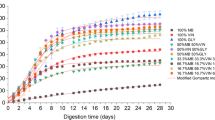Abstract
Objective
To determine Monod kinetics parameters (µmax, Ks, kd and YX/S) of the mesophilic H2 producer Clostridium termitidis grown on glucose and cellobiose by modeling in MATLAB.
Results
Maximum specific growth rates (µmax) were 0.22 and 0.24 h−1 for glucose and cellobiose respectively; saturation constants (Ks) were 0.17 and 0.38 g l−1 respectively and the biomass yields (YX/S) were 0.26 and 0.257 g dry wt g−1 substrate. H2 yields of 1.99 and 1.11 mol H2 mol−1 hexose equivalent were also determined for glucose and cellobiose respectively.
Conclusion
The microbial kinetics of this model microorganism will enhance engineering biofuel production applications.



Similar content being viewed by others
References
Alalayah WM, Kalil MS, Kadhum AAH, Jahim J, Zaharim A, Alauj NM, El-Shafie A (2010) Applications of the box-wilson design model for bio-hydrogen production using Clostridium saccharoperbutylacetonicum N1-4 (ATCC 13564). Pak J Biol Sci 13:674–682
Atkinson B, Mavituna F (1991) Biochemical engineering and biotechnology handbook. Stockton Press, New York
Fang HHP (2010) Environmental anaerobic technology: applications and new developments. Imperial College Press, London
Giallo J, Gaudin C, Belaich JP (1985) Metabolism and solubilization of cellulose by Clostridium cellulolyticum H10. Appl Environ Microbiol 49:1216–1221
Hethener P, Brauman A, Garcia JL (1992) Clostridium termitidis sp. nov., a cellulolytic bacterium from the gut of the wood-feeding termite, Nasutitermes lujae. Syst Appl Microbiol 15:52–58
Lal S, Ramachandran U, Zhang X, Munir R, Sparling R, Levin DB (2013) Draft genome sequence of the cellulolytic, mesophilic, anaerobic bacterium Clostridium termitidis strain CT1112 (DSM 5398). Genome Announc 1:e00281–e00283
Levin DB, Carere CR, Cicek N, Sparling R (2009) Challenges for biohydrogen production via direct lignocellulose fermentation. Int J Hydrog Energy 34:7390–7403
Lin PY, Whang LM, Wu YR, Ren WJ, Hsiao CJ, Chang SLLS (2007) Biological hydrogen production of the genus Clostridium: metabolic study and mathematical model simulation. Int J Hydrog Energy 32:1728–1735
Linville JL, Rodriguez M, Mielenz JR, Cox CD (2013) Kinetic modeling of batch fermentation for Populus hydrolysate tolerant mutant and wild type strains of Clostridium thermocellum. Bioresour Technol 147:605–613
López S, Dhanoa MS, Dijkstra J, Bannink A, Kebreab E, France J (2007) Some methodological and analytical considerations regarding application of the gas production technique. Anim Feed Sci Technol 135:139–156
Munir RI, Schellenberg J, Henrissat B, Verbeke TJ, Sparling R, Levin DB (2014) Comparative analysis of carbohydrate active enzymes in Clostridium termitidis CT1112 reveals complex carbohydrate degradation ability. PLoS One 9:e104260
Owen WF, Stuckey DC, Healy JB, Young LY, Mccarty PL (1979) Bioassay for monitoring biochemical methane potential and anaerobic toxicity. Water Res 13:485–492
Ramachandran U, Wrana N, Cicek N, Sparling R, Levin DB (2008) Hydrogen production and end-product synthesis patterns by Clostridium termitidis strain CT1112 in batch fermentation cultures with cellobiose or α-cellulose. Int J Hydrog Energy 33:7006–7012
Schwarz WH (2001) The cellulosome and cellulose degradation by anaerobic bacteria. Appl Microbiol Biotechnol 56:634–649
Shuler ML, Kargı F (2002) Bioprocess engineering: basic concepts, 2nd edn. Prentice Hall PTR, Upper Saddle River
Sleat R, Mah RA, Robinson R (1984) Isolation and characterization of an anaerobic, cellulolytic bacterium, Clostridium cellulovorans sp. nov. Appl Environ Microbiol 48:88–93
Srivastava AK, Volesky B (1990) Updated model of the batch acetone–butanol fermentation. Biotechnol Lett 12:693–698
Warnick TA, Methé BA, Leschine SB (2002) Clostridium phytofermentans sp. nov., a cellulolytic mesophile from forest soil. Int J Syst Evol Microbiol 52:1155–1160
Yang XP, Tsao GT (1994) Mathematical-modelling of inhibition-kinetics in acetone-butanol fermentation by Clostridium acetobutylicum. Biotechnol Prog 10:532–538
Acknowledgments
This work was supported by the Eastern platform of the Biofuel Network. The authors acknowledge the support by Consejo Nacional de Ciencia y Tecnologia de Mexico (CONACYT) and Alianza para la Formacion e Investigacion en Infraestructura para el Desarrollo de Mexico, awarded to Maritza Gomez-Flores.
Supporting information
Supplementary Figure 1—Correlation between dry wt and cellular protein content in Clostridium termitidis.
Author information
Authors and Affiliations
Corresponding author
Electronic supplementary material
Below is the link to the electronic supplementary material.
Rights and permissions
About this article
Cite this article
Gomez-Flores, M., Nakhla, G. & Hafez, H. Microbial kinetics of Clostridium termitidis on cellobiose and glucose for biohydrogen production. Biotechnol Lett 37, 1965–1971 (2015). https://doi.org/10.1007/s10529-015-1891-4
Received:
Accepted:
Published:
Issue Date:
DOI: https://doi.org/10.1007/s10529-015-1891-4




